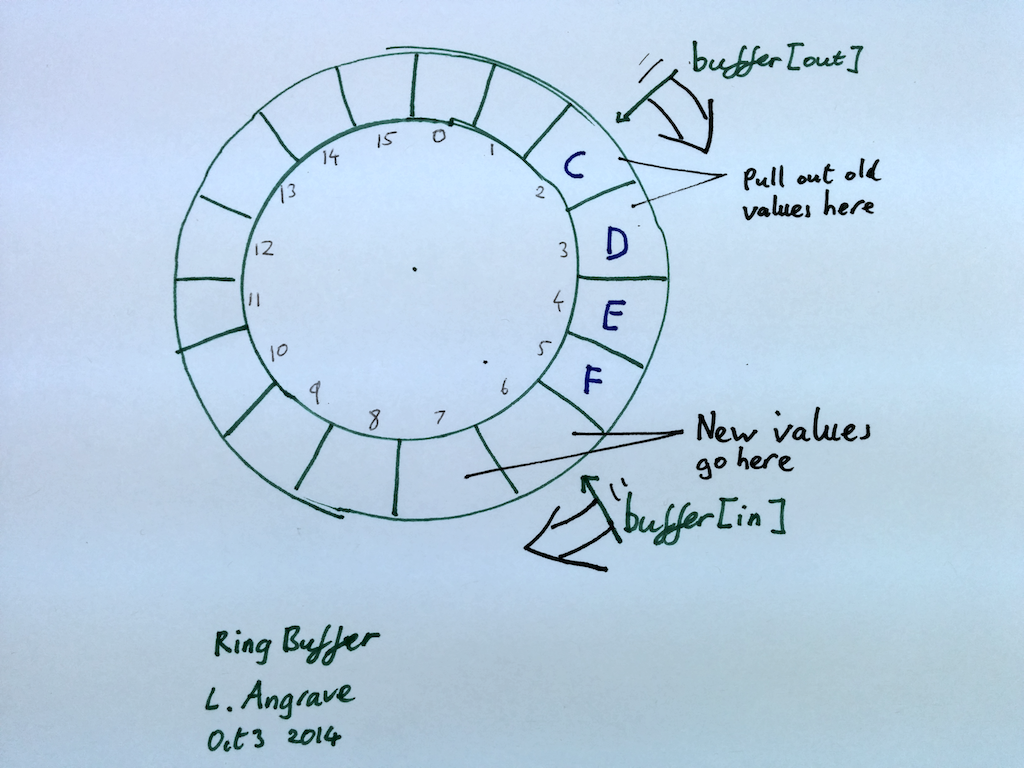# 同步,第 8 部分:环形缓冲区示例
> 原文:<https://github.com/angrave/SystemProgramming/wiki/Synchronization%2C-Part-8%3A-Ring-Buffer-Example>
## 什么是环形缓冲区?
环形缓冲区是一种简单的,通常是固定大小的存储机制,其中连续内存被视为圆形,两个索引计数器跟踪队列的当前开始和结束。由于数组索引不是循环的,因此当移过数组末尾时,索引计数器必须回绕到零。当数据被添加(入队)到队列的前面或从队列的尾部移除(出队)时,缓冲区中的当前项形成一条似乎环绕轨道的列车一个简单的(单线程)实现如下所示。注意 enqueue 和 dequeue 不会防止下溢或溢出 - 当队列已满时可以添加项目,并且当队列为空时可以删除项目。例如,如果我们将 20 个整数(1,2,3 ...)添加到队列中并且没有使任何项目出列,则值`17,18,19,20`将覆盖`1,2,3,4`。我们现在不会解决这个问题,相反,当我们创建多线程版本时,我们将确保在环形缓冲区满或空时分别阻塞入队和出队线程。
```c
void *buffer[16];
int in = 0, out = 0;
void enqueue(void *value) { /* Add one item to the front of the queue*/
buffer[in] = value;
in++; /* Advance the index for next time */
if (in == 16) in = 0; /* Wrap around! */
}
void *dequeue() { /* Remove one item to the end of the queue.*/
void *result = buffer[out];
out++;
if (out == 16) out = 0;
return result;
}
```
## 实现环形缓冲区有什么问题?
以下面的紧凑形式编写入队或出队方法非常诱人(N 是缓冲区的容量,例如 16):
```c
void enqueue(void *value)
b[ (in++) % N ] = value;
}
```
这种方法似乎有效(通过简单的测试等),但包含一个微妙的 bug。有足够的入队操作(超过 20 亿),`in`的 int 值将溢出并变为负值!模数(或“余数”)运算符`%`保留符号。因此,您最终可能会写入`b[-14]`!
紧凑的形式是正确的使用位屏蔽,只要 N 是 2 ^ x(16,32,64,...)
```c
b[ (in++) & (N-1) ] = value;
```
此缓冲区尚未阻止缓冲区下溢或溢出。为此,我们将转向我们的多线程尝试,它将阻塞线程,直到有空间或至少有一个项目要删除。
## 检查多线程实现的正确性(示例 1)
以下代码是不正确的实现。会发生什么? `enqueue`和/或`dequeue`会阻塞吗?相互排斥是否满足?缓冲区可以下溢吗?缓冲区可以溢出吗?为清楚起见,`pthread_mutex`缩短为`p_m`,我们假设 sem_wait 不能被中断。
```c
#define N 16
void *b[N]
int in = 0, out = 0
p_m_t lock
sem_t s1,s2
void init() {
p_m_init(&lock, NULL)
sem_init(&s1, 0, 16)
sem_init(&s2, 0, 0)
}
enqueue(void *value) {
p_m_lock(&lock)
// Hint: Wait while zero. Decrement and return
sem_wait( &s1 )
b[ (in++) & (N-1) ] = value
// Hint: Increment. Will wake up a waiting thread
sem_post(&s1)
p_m_unlock(&lock)
}
void *dequeue(){
p_m_lock(&lock)
sem_wait(&s2)
void *result = b[(out++) & (N-1) ]
sem_post(&s2)
p_m_unlock(&lock)
return result
}
```
## 分析
在阅读之前,看看你能找到多少错误。然后确定如果线程调用 enqueue 和 dequeue 方法会发生什么。
* enqueue 方法在同一个信号量(s1)上等待和发布,类似于 equeue 和(s2),即我们递减值然后立即递增值,所以在函数结束时信号量值不变!
* s1 的初始值为 16,因此信号量永远不会减少到零 - 如果环形缓冲区已满,则 enqueue 不会阻塞 - 因此溢出是可能的。
* s2 的初始值为零,因此对 dequeue 的调用将始终阻塞并且永不返回!
* 需要交换互斥锁和 sem_wait 的顺序(但是这个例子很破坏,这个 bug 没有效果!)##检查多线程实现的正确性(例 1)
The following code is an incorrect implementation. What will happen? Will `enqueue` and/or `dequeue` block? Is mutual exclusion satisfied? Can the buffer underflow? Can the buffer overflow? For clarity `pthread_mutex` is shortened to `p_m` and we assume sem_wait cannot be interrupted.
```c
void *b[16]
int in = 0, out = 0
p_m_t lock
sem_t s1, s2
void init() {
sem_init(&s1,0,16)
sem_init(&s2,0,0)
}
enqueue(void *value){
sem_wait(&s2)
p_m_lock(&lock)
b[ (in++) & (N-1) ] = value
p_m_unlock(&lock)
sem_post(&s1)
}
void *dequeue(){
sem_wait(&s1)
p_m_lock(&lock)
void *result = b[(out++) & 15]
p_m_unlock(&lock)
sem_post(&s2)
return result;
}
```
### 分析
* s2 的初始值为 0.因此,即使缓冲区为空,enqueue 也会在第一次调用 sem_wait 时阻塞!
* s1 的初始值为 16.因此即使缓冲区为空,dequeue 也不会在第一次调用 sem_wait 时阻塞 - oops 下溢! dequeue 方法将返回无效数据。
* 该代码不满足互斥;两个线程可以同时修改`in`或`out`!该代码似乎使用互斥锁。不幸的是锁从未用`pthread_mutex_init()`或`PTHREAD_MUTEX_INITIALIZER`初始化 - 所以锁可能不起作用(`pthread_mutex_lock`可能什么都不做)
## 正确实现环形缓冲区
伪代码(`pthread_mutex`缩短为`p_m`等)如下所示。
由于互斥锁存储在全局(静态)内存中,因此可以使用`PTHREAD_MUTEX_INITIALIZER`进行初始化。如果我们为堆上的互斥锁分配了空间,那么我们就会使用`pthread_mutex_init(ptr, NULL)`
```c
#include <pthread.h>
#include <semaphore.h>
// N must be 2^i
#define N (16)
void *b[N]
int in = 0, out = 0
p_m_t lock = PTHREAD_MUTEX_INITIALIZER
sem_t countsem, spacesem
void init() {
sem_init(&countsem, 0, 0)
sem_init(&spacesem, 0, 16)
}
```
入队方法如下所示。注意:
* 锁定仅在关键部分(访问数据结构)期间保持。
* 由于 POSIX 信号,完整的实现需要防止`sem_wait`的早期返回。
```c
enqueue(void *value){
// wait if there is no space left:
sem_wait( &spacesem )
p_m_lock(&lock)
b[ (in++) & (N-1) ] = value
p_m_unlock(&lock)
// increment the count of the number of items
sem_post(&countsem)
}
```
`dequeue`实现如下所示。请注意同步调用`enqueue`的对称性。在这两种情况下,如果空格计数或项目数为零,则函数首先等待。
```c
void *dequeue(){
// Wait if there are no items in the buffer
sem_wait(&countsem)
p_m_lock(&lock)
void *result = b[(out++) & (N-1)]
p_m_unlock(&lock)
// Increment the count of the number of spaces
sem_post(&spacesem)
return result
}
```
## 值得深思
* 如果交换`pthread_mutex_unlock`和`sem_post`调用的顺序会发生什么?
* 如果交换`sem_wait`和`pthread_mutex_lock`调用的顺序会发生什么?
- UIUC CS241 系统编程中文讲义
- 0. 简介
- #Informal 词汇表
- #Piazza:何时以及如何寻求帮助
- 编程技巧,第 1 部分
- 系统编程短篇小说和歌曲
- 1.学习 C
- C 编程,第 1 部分:简介
- C 编程,第 2 部分:文本输入和输出
- C 编程,第 3 部分:常见问题
- C 编程,第 4 部分:字符串和结构
- C 编程,第 5 部分:调试
- C 编程,复习题
- 2.进程
- 进程,第 1 部分:简介
- 分叉,第 1 部分:简介
- 分叉,第 2 部分:Fork,Exec,等等
- 进程控制,第 1 部分:使用信号等待宏
- 进程复习题
- 3.内存和分配器
- 内存,第 1 部分:堆内存简介
- 内存,第 2 部分:实现内存分配器
- 内存,第 3 部分:粉碎堆栈示例
- 内存复习题
- 4.介绍 Pthreads
- Pthreads,第 1 部分:简介
- Pthreads,第 2 部分:实践中的用法
- Pthreads,第 3 部分:并行问题(奖金)
- Pthread 复习题
- 5.同步
- 同步,第 1 部分:互斥锁
- 同步,第 2 部分:计算信号量
- 同步,第 3 部分:使用互斥锁和信号量
- 同步,第 4 部分:临界区问题
- 同步,第 5 部分:条件变量
- 同步,第 6 部分:实现障碍
- 同步,第 7 部分:读者编写器问题
- 同步,第 8 部分:环形缓冲区示例
- 同步复习题
- 6.死锁
- 死锁,第 1 部分:资源分配图
- 死锁,第 2 部分:死锁条件
- 死锁,第 3 部分:餐饮哲学家
- 死锁复习题
- 7.进程间通信&amp;调度
- 虚拟内存,第 1 部分:虚拟内存简介
- 管道,第 1 部分:管道介绍
- 管道,第 2 部分:管道编程秘密
- 文件,第 1 部分:使用文件
- 调度,第 1 部分:调度过程
- 调度,第 2 部分:调度过程:算法
- IPC 复习题
- 8.网络
- POSIX,第 1 部分:错误处理
- 网络,第 1 部分:简介
- 网络,第 2 部分:使用 getaddrinfo
- 网络,第 3 部分:构建一个简单的 TCP 客户端
- 网络,第 4 部分:构建一个简单的 TCP 服务器
- 网络,第 5 部分:关闭端口,重用端口和其他技巧
- 网络,第 6 部分:创建 UDP 服务器
- 网络,第 7 部分:非阻塞 I O,select()和 epoll
- RPC,第 1 部分:远程过程调用简介
- 网络复习题
- 9.文件系统
- 文件系统,第 1 部分:简介
- 文件系统,第 2 部分:文件是 inode(其他一切只是数据...)
- 文件系统,第 3 部分:权限
- 文件系统,第 4 部分:使用目录
- 文件系统,第 5 部分:虚拟文件系统
- 文件系统,第 6 部分:内存映射文件和共享内存
- 文件系统,第 7 部分:可扩展且可靠的文件系统
- 文件系统,第 8 部分:从 Android 设备中删除预装的恶意软件
- 文件系统,第 9 部分:磁盘块示例
- 文件系统复习题
- 10.信号
- 过程控制,第 1 部分:使用信号等待宏
- 信号,第 2 部分:待处理的信号和信号掩码
- 信号,第 3 部分:提高信号
- 信号,第 4 部分:信号
- 信号复习题
- 考试练习题
- 考试主题
- C 编程:复习题
- 多线程编程:复习题
- 同步概念:复习题
- 记忆:复习题
- 管道:复习题
- 文件系统:复习题
- 网络:复习题
- 信号:复习题
- 系统编程笑话
